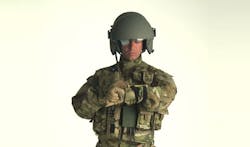Raytheon increases pilot situational awareness with Aviation Warrior wearable computer, monocle display
WALTHAM, Mass., 13 Dec. 2012. New wearable computer technology is enabling pilots to peer through dust storms and see through the floor of their aircraft, says a Raytheon spokesperson.
A new wearable communications system from Raytheon puts maps and video on pilots’ wrists.
“We are moving into an unprecedented period of cutting-edge pilot capabilities,” explains Todd Lovell, a Raytheon engineer and former V-22 Osprey pilot. “We’re using not only sight but also hearing to help pilots process all the information coming into the cockpit.”
| Related info -- Avionics Europe 2013, in Munich on 20 and 21 Feb. 2013, will feature an interactive panel discussion on cockpit display technologies. |
All of the key visual data an aviator needs can be presented in a heads-up manner through a monocle positioned just in front of the pilot’s eye.
The technology allows pilots to hear where hostile fire is coming from through 3D audio in their helmets. A sophisticated system of sensors outside the aircraft provides spherical vision in degraded visual environments, from dust storms to the black of a moonless night.
“It’s like flying in a glass ball,” says Trevor Bushell, business development manager for Raytheon’s Advanced Distributed Aperture System.
Breakthroughs include:
The modular Advanced Distributed Aperture System (ADAS) delivers expanded, high-resolution infrared and near-infrared imagery to the pilot and crew. The system allows pilots to see through the walls and floor of the aircraft, a potential life-saver when landing a helicopter in a dust cloud or in darkness.
The Raytheon Center Display Unit, which allows militaries to replace the analog instruments in their F-16s and helicopters with a new, flat-screen digital display. The richer data stream can then be sent directly to the pilot’s helmet.
The Aviation Warrior wearable computer comes with a wrist-mounted screen, allowing pilots to see radar images, surveillance video, and maps even when on the ground. They also can communicate with a built-in radio or by text.
Follow Avionics Intelligence news updates on Twitter (@Avionics_Intel), LinkedIn, and Google+.
